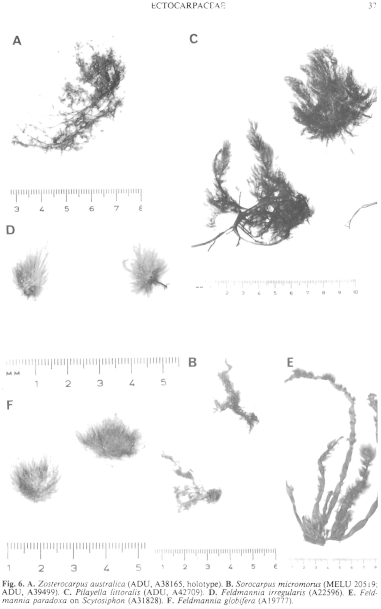|
|
|
|
|
|||||||||||
|
Electronic Flora of South Australia Species Fact Sheet
Phylum Phaeophyta – Order Ectocarpales
Selected citations: Clayton 1974: 799, fig. 32. Kornmann & Sahling 1977: 115, fig. 59; 1984:87, figs 5–7. Rosenvinge & Lund 1941:58, fig. 30. Taylor 1957: 117, pl. 9 fig. 6.
Thallus (Fig. 6B) medium brown, 1–4 cm long, tufted, irregularly branched with bare lower main branches (Fig. 7E). Filaments 55–70 µm in diameter below, cells L/B (0.5–) 0.7–1.3 (–1.5); branchlets 30–40 µm in diameter, cells L/B 0.5–1 (–1.5); phaeophycean hairs 10–14 µm in diameter. Cells (Fig. 7F) with numerous discoid phaeoplasts each with a pyrenoid, and few physodes.
Reproduction: Plurilocular organs (Fig. 7F) conical to ovoid, densely clustered in groups along the branchlets or on short laterals 2–3 cells long and thus forming irregularly shaped to sub-globular sori 40–80 µm long and 20–15 µm in diameter, with locules of sporangia 3–4 µm across.
Type from Hofmansgave, Denmark; in C (based on Ectocarpus siliculosus (3 uvaeformis Lyngbye 1819, p. 132, pl. 43D.)
Distribution: N. Europe and N.E. North America, N. Japan.
In Australia, known only from Mornington, Vic. (Clayton, 21.ix.1970; MELU, 20519, ADU, A39499).
Taxonomic notes: Sorocarpus micromorus is known in southern Australia only from the record of King & Ducker (1971, p. 116) and description of Clayton (1974, p. 799) from Mornington, Port Phillip, Vic., and may be an introduction from ships to this locality. Australian material needs further study in relation to the taxa distinguished by Takamatsu (1936) and Kornmann & Sahling (1984).
Abe (1935, p. 335) claimed to have observed fusion of gametes from plurilocular organs on different plants from northern Japan, but Pedersen (1974) and Clayton (1974, p. 799) found that zoospores from the plurilocular sporangia grew into plants similar to the parent and also bore plurilocular sporangia, thus demonstrating that these organs are neutral sporangia (on haploid plants according to Pedersen). Clayton also referred to and figured a unilocular sporangium terminal on a plurilocular organ; this may be only the "terminal cell" of the plurilocular sporangium referred to by Rosenvinge & Lund (1941, p. 59).
Pedersen (1977, p. 39) has erected the family Sorocarpaceae for Sorocarpus and two other genera, based on their sympodial growth and presence of phaeophycean hairs; the latter feature occurs in other genera of Ectocarpaceae (e.g. Kuckuckia) and the irregular sympodial growth scarcely warrants a separate family, as concluded by Kornmann & Sahling (1984).
References:
ABE, K. (1935). Zur Kenntnis der Entwicklungsgeschichte von Heterochordaria, Scytosiphon and Sorocarpus. Sci. Rep. Tohoku Imp. Univ. IV, biol., 9, 329–337, Plate 10.
CLAYTON, M.N. (1974). Studies on the development, life history and taxonomy of the Ectocarpales (Phaeophyta) in southern Australia. Aust. J. Bot. 22, 743–813.
KING, R.J. & DUCKER, S. (1971). In King, R.J., Black, J.H. & Ducker, S. Intertidal ecology of Port Phillip Bay, with systematic lists of plants and animals. 3. Flora of the intertidal region, pp. 112–128. Mem. Nat. Mus. Vic. 32, 93–128.
KORNMANN, P. & SAHLING, P.-H. (1977). Meeresalgen von Helgoland. Benthische Braun und Rotalgen. Helgol. wiss. Meeresunters. 29, 1–292.
KORNMANN, P. & SAHLING, P.-H. (1984). Der Sorocarpus-komplex (Ectocarpaceae, Phaeophyta). Helga wiss. Meeresunters. 38, 87–101.
LYNGBYE, H.CH. (1819). Tentamen Hydrophytologiae Danicae. (Copenhagen.) McCULLY, M.E. (1966). Histological studies on the genus Fucus I. Light microscopy of the mature vegetative plant. Protoplasma 62, 287–305, Fig. 1. MacLENNAN, I.G. (1956). A brown alga (Petrospongium rugosum) new to Victoria. Proc. R. Soc. Vict. 69, 1–3.
PEDERSEN, P.M. (1974). The life-history of Sorocarpus micromorus (Phaeophyceae, Ectocarpaceae) in culture. Br. phycol. J. 9, 57–61.
PEDERSEN, P.M. (1977). Polytretus reinboldii, a rare brown alga in culture (Ectocarpales, Sorocarpaceae fam. nov.). Bot. Not. 130, 35–40.
ROSENVINGE, L.K. & LUND, S. (1941). The marine algae of Denmark. Vol. II. Phaeophyceae. I. Ectocarpaceae and Acinetosporaceae. K. Dan. Vidensk. Selsk. Biol. Skr. 1(4), 1–79.
SILVA, P.C. (1950). Generic names of algae proposed for conservation. Hydrobiologia 2, 252–280.
TAKAMATSU, M. (1936). Sorocarpus aus der Matsushima-Bucht, (Prov. Miyagi, Japan), auch morphologisch untersucht. Saito Ho-on Kai Mus. Res. Bull. 8, 71–99, Plates 1–9.
TAYLOR, W.R. (1957). Marine algae of the Northeastern coast of North America. Rev. Edn. (Univ. Mich. Press: Ann Arbor.)
The Marine Benthic Flora of Southern Australia Part II complete list of references.
Publication:
Womersley, H.B.S. (14 December, 1987)
The Marine Benthic Flora of Southern Australia
Part II
©Board of the Botanic Gardens and State Herbarium, Government of South Australia
Illustrations in Womersley Part II, 1997: FIGS 6B, 7 E–F.

Figure 6 enlarge
Fig. 6. A. Zosterocarpus australica (ADU, A38165, holotype). B. Sorocarpus micromorus (MELU 20519; ADU, A39499). C. Pilayella littoralis (ADU, A42709). D. Feldmannia irregularis (A22596). E. Feldmannia paradoxa on Scytosiphon (A31828). F. Feldmannia globifera (A19777).

Figure 7 enlarge
Fig. 7. A–D. Zosterocarpus australica (ADU, A38165, holotype). A. Branch system bearing plurilocular sporangia. B. Mature cells with phaeoplasts and centrally aggregated physodes. C. Branchlet with apical cells and plurilocular sporangia, surface view. D. Ditto, median view. E–F. Sorocarpus micromorus (ADU, A39499). E. Branches with son of plurilocular sporangia. F. Cells with phaeoplasts and branch bearing clustered plurilocular sporangia. G–J. Pilayella littoralis (G–I, ADU, A42709; J, ADU, A55783). G. Branching pattern. H. Plurilocular sporangium intercalary on a branchlet. 1. Unilocular sporangia in branchlets. J. Filaments with rows of unilocular sporangia.

|
Email Contact: State Herbarium of South Australia |

|